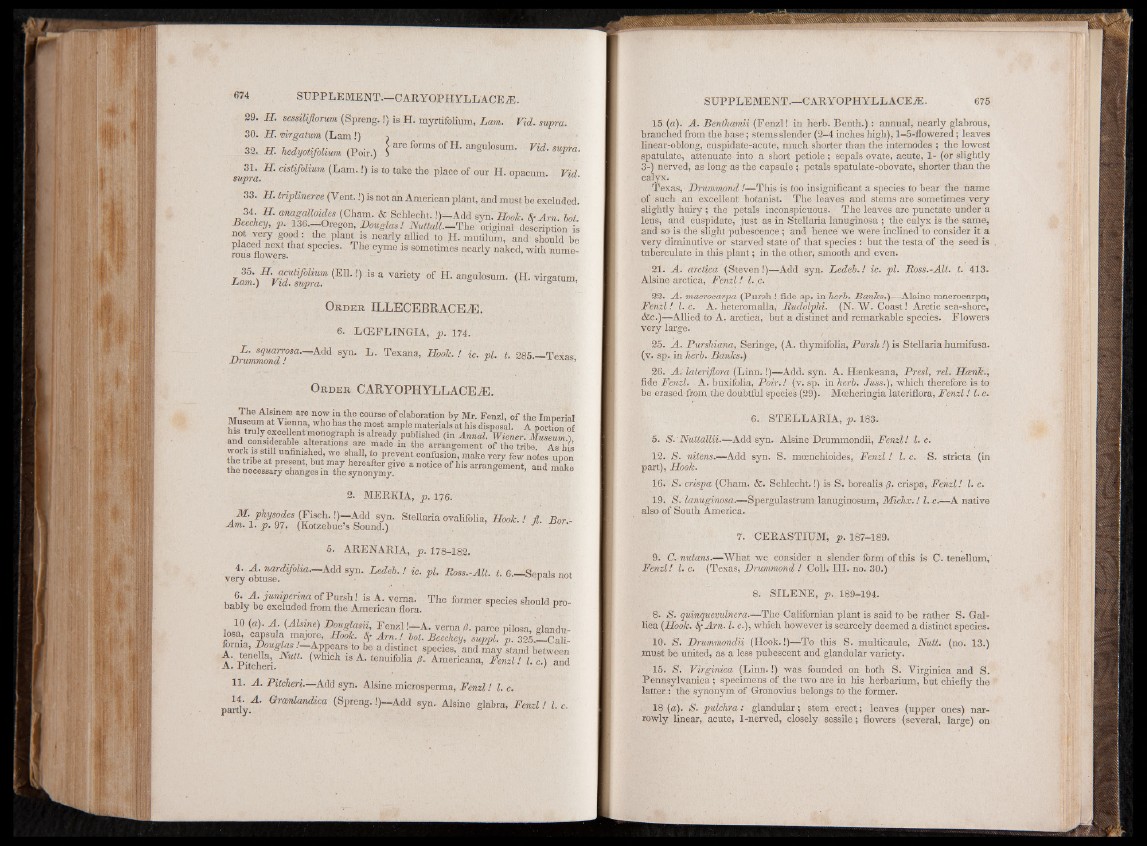
29. H. sessiliflorum (Spreng.!) is H. myrtifolium, Lam. Vid. supra.
30. H. virgatum (Lam !)
32, H. hedyotifolium (Poir.)
31. H. dstifolium (Lam .!) is to take the place of our H. opacum. Vid.
^ are forms of H. angulosum. Vid. supra.
supra
33. H. triplinerve (Vent.!) is not an American plant, and must be excluded.
34. H. anagalloides (Cham. & Schlecht.!)—Add syn. Hook, k Am . lot
Beechey, p. 136.—Oregon, Douglas! Nuttall— The original description is
X J o Z f v w placed next that species. The cyme is somett0im Hes. mneuatrillyu mna,k eadn,d w isthho unludm beerous
flowers. °
L a L )H n T S T (E1L 0 iS a Yarie,y °f k an§uIosum- (H. virgatum,
Or d e r ILLECEBRACEJE.
6. LCEFLINGIA, p. 174.
n u J Z 7 r ~ M d Syn' L - Texana’ Hook- •' *c- 1 - fc 285.—Texas,
Or d e r CARYOPHYLLACEiE.
The Alsineae are now in the course of elaboration by Mr. Fenzl, of the Imperial
Museum at Vienna, who has the most ample materials at his disposal. A portion of
his truly excellent monograph is already published (in Annul. Wiener. Museum)
and considerable alterations are made m the arrangement of the tribe As bis
the^-ihe t1 uufinf h®d.’ we s mlI>t0 prevent confusion, make very few notes upon
tJhbee necessarpyr ecfha n’g besu itn the hsyerneoanfytemr yg.i ve a notice of his arran6g ement,’ and mmaaknee
2. MERKIA, p. 176,
M. physodes (Fisch.!)—Add syn. Stellaria ovalifolia, Hook.! fl. Bor.-
A m .l .p .9 7 , (Kotzebue’s Sound.) J
5. ARENARIA, p. 178-182.
very ^ ^ '• *C- pL Ross--AU- b 6— Sepals not
bb ably be excluded from the Amise rAic' avne frlnoar‘a . The s e c ie s should p”roDouglasii,
F en zl!—A. vema 0. parce pilosa, glandu-
losa, capsula majore, Hook. A m .! lot. Beechey, suppl. p. 325.—Cali-
A ^ e n ^ r ^ V ^ '/ - tAlt?eurS t0Abe a d ? : DCt sPecie8’ and may f t and between
A Pitche ’ N U' WhlCh 18 A‘ tenmfolla P- Americana, Fenzl! % c.) and
11. A. Pitched.—Add syn. Alsinemicrosperma, Fenzl! 1. c.
partly^' Granlandica ( W 0—Add syn, Alsine glabra, Fenzl ! 1. c.
15 (a). A. Benthamii (Fenzl! in herb. Benth.): annual, nearly glabrous,
branched from the base; stems slender (2-4 inches high), 1-5-flowered; leaves
linear-oblong, cuspidate-acute, much shorter than the internodes ; the lowest
spatulate, attenuate into a short petiole ; sepals ovate, acute, 1- (or slightly
3-) nerved, as long as the capsule .petals spatulate-obovate, shorter than the
calyx.
Texas, Drummond!—This is too insignificant a species to bear the name
of such an excellent botanist. The leaves and stems are sometimes very
slightly hairy ; the petals inconspicuous. The leaves are punctate under a
lens, and cuspidate, just as in Stellaria lanuginosa ; the calyx is the same,
and so is the slight pubescence ; and hence we were inclined to consider it a
very diminutive or starved state of that species : but the testa of the seed is
tuberculate in this plant; in the other, smooth and even.
21. A. arctica (Steven!)—Add syn. Ledeb.! ic. pi. Ross.-Alt. t. 413.
Alsine arctica, Fenzl! 1. c.
22. A. macrocarpa (Pursh ! fide sp. in herl. Banks.)—Alsine macrocarpa,
Fenzl ! l. e. A. heteromalla, Rudolphi. (N. W. Coast! Arctic sea-shore,
&c.)—Allied to A. arctica, but a distinct and remarkable species. Flowers
very large.
25. A. Purshiana, Seringe, (A. thymifolia, Pursh !) is Stellaria humifusa.
(v. sp. in herl. Banks.)
26. A. lateriflora (Linn.!)—Add. syn. A. Haenkeana, Presl, rel. Hcenk.,
fide Fenzl. A. buxifolia, Poir.! (v. sp. in herl. Juss.), which therefore is to
be erased-from the doubtful species (29). Moeheringia lateriflora, Fenzl! l.c.
6. STELLARIA, p. 183,
5. S.'Nuttallii.—Add syn. Alsine Drummondii, Fenzl! l.c.
12. S. nitens.—Add syn. S. moenchioides, Fenzl! 1. c. S. stricta (in
part), Hoofl.
16. iS. crispa (Cham. &. Schlecht.!) is S. borealis 0. crispa, Fenzl! it c.
19, S. lanuginosa.—Spergulastrum lanuginosum, Michx.! 1. c.—A native
also of South America.
7. CERASTIUM, p. 187-189.
9. C. nutans.—What we consider a slender form of this is C. tenellum,'
Fenzl! 1. c. (Texas, Drummond ! Coll. III. no. 30.)
8. SILENE, p. 189-194.
8. iS. quinquemdnera.—The Californian plant is said to be rather S. Gal-
lica (Hook. fl-Am. 1. c.), whieh however is scarcely deemed a distinct species.
10. S. Drummondii (Hook.!)—To this S. multicaule, Nutt. (no. 13.)
must be united, as a less pubescent and glandular variety.
15. S. Virginica (Linn.!) was founded on both S. Virginica and S.
Pennsylvania ; specimens of the two are in his herbarium, but chiefly the
latter : the synonym of Gronovius belongs to the former.
18(a). 5!. pulchra: glandular; stem erect; leaves (upper ones) narrowly
linear, aeute, 1-nerved, closely sessile; flowers (several, large) on